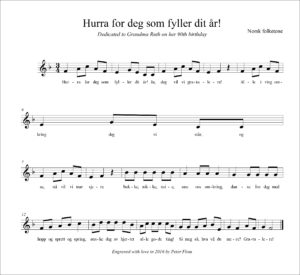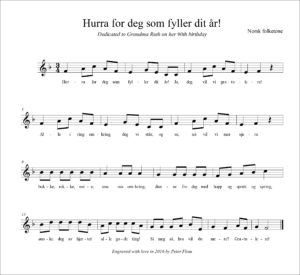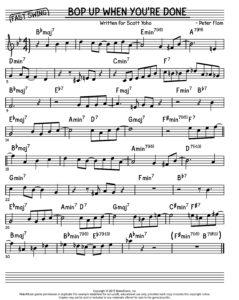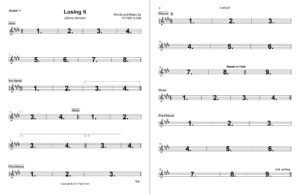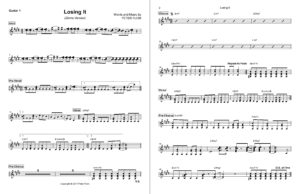In part one of this post, we identified some quick ways to make your charts more readable. We focused on beaming, rests, chord symbols, and comping notation. Today, we zoom out and concentrate on how your music occupies the page. As before, our focus is to empower sight reading and accurate performances.
Phrasing and Spacing
I believe the most important step in writing contemporary music is spacing the music appropriately. Take a look at this example (click on an image for a larger view):
Observe how difficult it is to read this example, especially in the second and fourth systems. In the former, the spacing is so loose that it’s difficult for your eyes to move quickly along with the music. In the latter, the opposite problem occurs – the music is too close together, is difficult to follow, and looks like a jumbled mess.
Fortunately, a few quick fixes with the up and down arrow keys in Finale can clean this part up well:
What I’m doing here is changing the number of measures per system. This is a concept known as “phrasing” in copyist work. Traditionally, the copyist must plan each system out before even starting any work. In Finale it only takes a few keystrokes to “re-flow” the systems into better spacing.
When you’re still composing, I recommend ignoring the layout as you write. Finale’s scroll view is perfect for separating the tasks of writing with layout. If you prefer working in page view, I suggest keeping your spacing wide open while you write. Try for only 3 or 4 measures per system. This can create a lot of extra pages, but after you finish you can go back and reflow systems together to save space.
Layout Considerations
After notation is perfected within the staff, the next dilemma is of page sizes. While Finale’s default document uses “letter” sized paper (8.5 x 11) to ensure everyone can print what they create, publisher parts made in the U.S. are often written on “concert” paper (9 x 12). Traditionally, concert manuscript paper was sold with 10 or 12 lines per sheet, and offered either narrow or wide spacing.
Today, these paper dimensions may not always available at an office supply store, but they can easily be found online. The larger size affords more space and larger staves; it is considerably easier to read than on computer paper. Best of all, formatting for this size needs only a quick trip to the Page Layout > Page Size dialog box in Finale.
Many commercial parts are written on this type of manuscript paper. Copyists often left the top two staves of the first page for the title, creating the “fake book” appearance seen in many jazz parts. Even without blank staves on your score, it’s a good idea to leave two staves worth of empty space at the top of the first page for your title, part name, and other information.
Page Turns and Fills
From there, the last two considerations are page turns and fills. Page turns are often pretty obvious: don’t make it hard for your performer to turn the page. Try to reflow your systems so that page turns happen during a large break in the music. If your performer must play through the page turn, try to make the turn occur where they can continue playing while they turn, or while they’re playing a part that is doubled by another instrument.
Finally, a good practice is to try and fill the last page of your part as much as possible. The best way to do this is to plan the part out separately, using a chart like the one below:
Normally I would make the above chart by hand on manuscript paper first. I made this one in Finale to spare you from suffering the illegibility of my poor handwriting.
Here’s what the actual chart looks like:
As you can see, I had to weigh many factors, including song length, measure phrasing, multi-measure rests, repeats, and page turns. My goal was to use up all systems on both pages, but as long as my last page is more than 60% covered I’m comfortable sending it off to my players.
I hope you’ve found these tips useful. I believe that adapting these simple practices in your writing will benefit most contemporary ensembles.
Please let us know via Facebook or Twitter what other quick tips you use to add magic to your sheet music.
